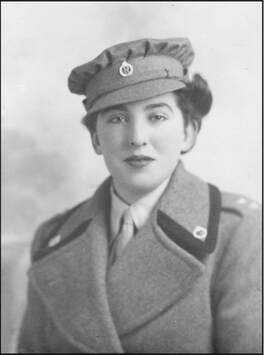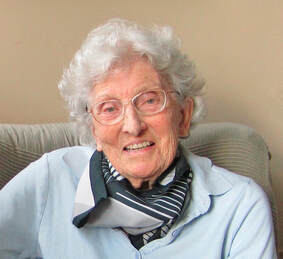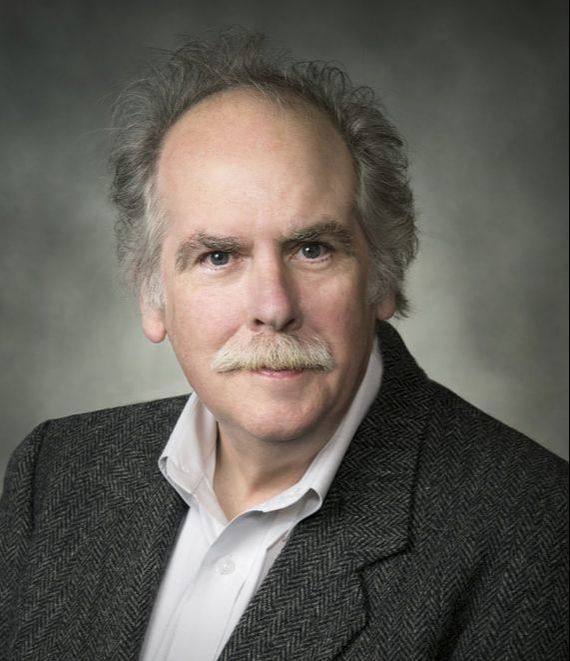 SHEILA JARVIS (1921 – 2019) SHEILA JARVIS (1921 – 2019) LONDON, ONTARIO – It was on a train ride home from Niagara Falls in the early autumn of 1977 that Kirtley and I mysteriously managed to become engaged. We have never been able to recall which one of us started to incline our conversation in the direction of matrimony. In addition to feeling depressed, ripped off and grossed out by the tacky excesses of Canada’s metropolis of bad taste, had we somehow been subliminally bewitched by our flying visit to the Honeymoon Capital of the World? So it would seem. As our train pulled into the London station we took hold of ourselves and agreed that, “Yes, we’re probably engaged but because we don’t have a clue what any of this means or why we’re even talking this way, we’d better not tell anyone just yet. Okay?” Then Kirtley went home and impulsively blurted the news to her Scottish-born mom. I did not blame Kirtley for spilling the beans. We’d been going out, off and on, hot and cold, smooth and crunchy, for seven years by then and it was clearly time to move things along to the next plateau. Sheila’s first reaction to the news that her daughter intended to get married was to copiously congratulate her for a couple minutes and then to seek out some supplementary information that might possibly be germane: “And who is it that you’ll be marrying, darling?” We really had been sufficiently neurotic and erratic in our courtship that it’s small wonder my mother-in-law-to-be was uncertain. But the immediate encouragement she displayed that day was emblematic of the unflagging support I have watched her extend for nearly half a century to all of her offspring in all of their endeavours – even the hopelessly romantic ones or the impractical artistic ones that might not hold much immediate promise in the remuneration department but are essential for the good of one’s soul. Sheila always understood how a life’s purpose can crystallize in an instant when all of the elements suddenly align themselves just so. She understood this because it happened to her at the age of 24 when, after an early life of considerable hardship and struggle, she was stationed in India as a nurse in the closing days of the Second World War with the Queen Alexandra Imperial Military Reserve and fell in love with an RCAF radar operator from some godforsaken corner of the globe called London, Ontario. His unpromising origins notwithstanding, William Lawrence Jarvis was a whip-smart man with a kind and courteous nature whose sensibilities quite magically chimed with her own. Here was a man she could trust with her life. Not even five weeks after meeting, they were wed. While the prospect of imminent demobilization loaned a certain urgency to their courtship, it is an article of family legend that what really impelled Sheila to take Bill up on the garbled telegraphic proposal he sent her – “CAN YOU COME TO BOMBAY TO HARRY?” - was his know-how in brewing a decent cup of tea outdoors. Many of us are alive to such configurations of fate when we’re young and downplay them later as we come to prefer a more cautious and measured approach to life. Sheila never shut down her openness, her wonder, in that way. And it was this quality that made her – all the way into her 99th year – an instinctive ally of youth and artists of every stripe. On my very first visit to the Jarvis residence, I was mightily impressed that they'd handed over their garage to Kirtley's brother Bentley so he'd have his own private quarters-cum-studio in which to build his own musical synthesizer. All of our children knew their Gran was solidly stationed in their corner and sought her out at key passages in their development when siblings, peers and parents just couldn’t offer the required perspective. Bonnie was particularly notorious during her chequered high school career for impulsively cutting class on those days when she ceased to comprehend the point of all this so-called ‘education’. So what was the first thing the kid thought of to do with her illicitly won freedom? Did she go hang out at the mall, or meet some guy we wouldn’t have approved of, or score some deals in controlled substances? Nope, none of it. She’d head over to her Gran’s for some inter-generational therapy. Maybe they’d flick their way through a few issues of Vogue or Elle. “Oh, I like that one.” “Does this do anything for you?” “Do you see what they’re doing here?” A magnificent seamstress and a tireless knitter, there was nothing about clothing Sheila didn’t understand. Or, if conditions were propitious, they’d pack up a flask of tea and head out on the lam, taking one of Gran’s beloved drives along the deserted Lake Erie shore where they could talk about matters of love and destiny in an open-ended way. I had the pleasure of knowing Sheila Jarvis for two thirds of my life, and one half of hers. All through those years she’d been dropping tantalizing hints about her life story; usually as part of our discussion about a book, a play, or a piece of music. In the very early years of our marriage I was reading (and thoroughly enjoying) a lavishly illustrated biography of Noel Coward that I was reviewing for the Free Press. Sheila was intrigued that anyone of my generation would have any use for a talent that spoke so strongly to the years of her own youth and she recalled to me her own brush with the master out in India. At our kiddie-crammed Port Bruce cottage several years later, she took up a biography of Hilaire Belloc that I was reading and fastened on to a chapter concerning his years as a scholar at Oxford University, opening up a rich vein of lore from her own young adulthood when she got to know that city of dreaming spires very well, though, alas, never as a student. As a big fan of all kinds of choral music, I learned a lot from Sheila about the English choral tradition, particularly the incomparably rich body of Christmas carols, which she knew inside out and backwards as the choir director and organist at the Anglican church in Red Lake, the northern Ontario mining community where Bill worked as a geologist until 1967. In nearby Balmertown where the family lived, Sheila was also instrumental in bringing another civilizational cornerstone to the backwoods – starting up and managing that town’s first library. All the Jarvis kids were born and raised in the north and loved it. While life in the bush is an adventure for kids (at least until the age of about 15), it can be a little hard on adults with a subscription to Vogue and a love for theatre and opera. (I expect she would’ve gone mad without CBC Radio.) For the most part Sheila coped admirably and did what she could to elevate her surroundings but occasionally had to make a break to the nearest big city for a mental health holiday, explaining to her brood, “Mommy’s going to Winnipeg to buy a new hat.” I will always be grateful for the two trips to Britain I undertook with Sheila and each of our daughters when they were about 12 years old. Who better to introduce them to the lay of that fabled land than this expat who never lost her accent? On the 1991 trip with Emily, we spent a day kicking around Cambridge where I’d admired a heroic statue of Alfred Lord Tennyson in the foyer of Trinity College Chapel. Twenty minutes later I was across the road in one of that town’s fabulous used book shops and, my interest recently piqued in Queen Victoria’s favourite poet laureate, I pulled down a hefty biography of Tennyson and started laughing when the book fell open to a frontispiece featuring a full-page photograph of the very same statue. “That’s the way to live, isn’t it?” said Sheila, gesturing with her hands like she was tugging on reins that gathered up culture and history and art and brought them all together. Unlike some of our other shared cultural touchstones, the glory of Christmas music was something that Sheila and I got to revisit every year via concerts or recordings. We had about a ten-year run when I took her as my guest to matinee performances of Handel’s Messiah on the second Sunday in December by the massed choirs, four soloists and orchestra that Gerry Fagan conducted in the sublime acoustics of St. Peter’s Cathedral. We always sat in the readers’ section of the pews to the west of the altar, where Sheila would be the first on her pins for the Hallelujah chorus as well as the ovation at the concert’s conclusion. Also without fail, we were always among the last to leave the concert space. Once she’d dried her eyes and recomposed herself, Sheila insisted on personally thanking and congratulating the trumpet player, the timpanist, the cellist, the harpsichordist (usually Marlene Fagan) and whichever other players were still left on the floor. I foolishly wondered at first if this might not be an imposition on exhausted performers who probably just wanted to pack up their gear and get home to supper. But one look at their beaming faces – is anybody ever irritated to be told they were marvelous? - soon assured me that the adoration was mutual.  Even after four decades of extensive interaction with Sheila, my first full reading of her privately printed memoir, What Are the Wild Waves Saying? in the winter of 2010 was a revelation. While there was absolutely nothing in the way she tells her story that invites sympathy or pity – indeed, the pluck with which she met every new challenge actively discouraged such feelings – I couldn’t help being struck by how hard and uncertain great swaths of her life had been. The very last phrase of her book is, “Learn to roll with the punches,” and this she had done again and again with such elan and quiet determination that the unimaginative might not appreciate that any punches had been thrown her way at all. She certainly didn’t dwell on them. Some calamities such as the death of her father when she was only 13 - he'd been gassed in World War I and it took another 15 years to kill him - and the great demotion in fortune and opportunity which his death set in motion for his widow and two daughters, were very lightly sketched. Others, such as the horrors she encountered as a nurse in the Second World War or the too-early death of Bill in 1992, she scarcely referred to at all, or approached obliquely. Her reticence regarding certain incidents said as much, or more, than any flat out statement could. Her brief description of a passing encounter with a hospital train of wounded and emaciated Australian prisoners of war, made it clear just how much her nursing work took out of her. The usually private Sheila took up her memoirist’s pen in the immediate wake of her 85th birthday. There had been a remarkable party for the occasion, attracting celebrants from near and far and nearly every period of her life. Touched by the number of people that turned out that day and wanting to remember it all as completely as she could, she decided to write it up and, in a tendency that tells us so much about her kind and considerate heart, her account was almost entirely about her guests. “It’s a promising start,” we told her. “You’ve obviously got a real flair. But why not write more about you? That’s the stuff we really need to hear about.” Over the next few years, she took up that challenge in concentrated fits and starts, with Moray taking dictation and typing up each new chapter and revision on his word processor. When Maggie was in town, she would jog Sheila’s memory along certain paths to round out various sections, and she sorted and selected the photographs along with Kirtley who also did the (I’m allowed to say this aren’t I?) utterly exquisite layout. I was happy at the time that we’d all encouraged her to write down her memories. Not only did it allow her family to see the larger patterns and themes of a surprisingly adventurous and courageous life, I think it helped Sheila too and became a source of quiet pride for her. And right now, when all of us long so much to hear her voice once more, it is – along with our memories – the most precious resource we have. Even as she lay dying this past week – and before succumbing to those final three days’ silence when there were no words and, for the first time in about 96 years, no tea – she was attending to the comfort of her would-be comforters. “Is that chair all right for you?” “Would you care for a biscuit? I think I have some in the drawer.” On one of the last of their visits where words were exchanged, Kirtley was adjusting blankets and the pillow and stroking her mom’s brow when Sheila said, “There now, darling. There now,” raising the question, just who was consoling who? And so at last comes the long-dreaded day and here all we poor lost orphans congregate to express gratitude for her life. “Time, not money, is the new luxury commodity,” Sheila told me about 15 years ago, which impressed me so much that I stole it (with attribution) and built a column around it. Sheila Gerard Bentley Jarvis (nee) Cranch got 98 years, one month and three days on this side of the sod. It would strain all credibility to stand here and say that we or she were robbed. We might feel that way today and for a little while yet but surely, and however dimly, we must already apprehend that the precise opposite is the truth; that we all have been supreme beneficiaries to have shared such a magnitude of time on this planet with a woman who gave so much.
1 Comment
RoseMarie Forbes
3/3/2019 03:22:14 pm
My sincere condolences to you and your wife as you deal with the loss of this amazing woman!!
Reply
Your comment will be posted after it is approved.
Leave a Reply. |
HERMANEUTICS
If you would like to contribute to the ongoing operations of Hermaneutics, there are now a few options available.
ALL LIFE IS A GIFT :
THE IMPORTANCE OF TRADITION :
Archives
June 2024
Categories
|

 RSS Feed
RSS Feed